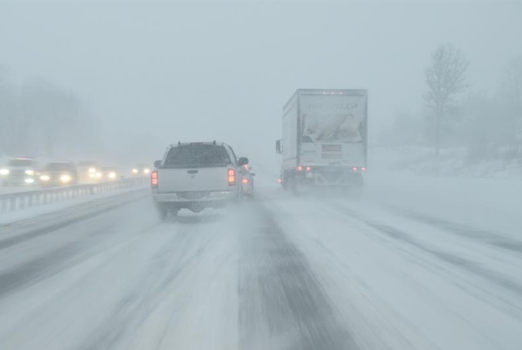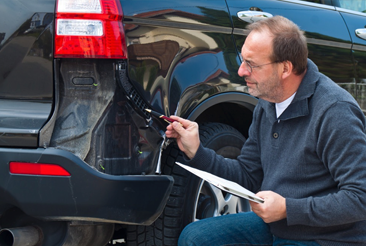 Motor vehicle incidents in Ontario account for more than 38 percent of all worker traumatic fatalities.
Motor vehicle incidents in Ontario account for more than 38 percent of all worker traumatic fatalities.
Planning to travel and visit relatives over the holidays? Here’s one winter driving scenario you could experience: First, there’s a moment of incomprehension when your steering wheel suddenly refuses to do your bidding. Panic starts to set in, your vehicle skates along the road – you’re no longer steering but praying you don’t veer into oncoming traffic.
You see the faces of happy families blur by in the opposing lane of holiday traffic, oblivious to a potential imminent collision. Time seems to surreally slow down as your brain grasps for information on what to do in a skid. You take your foot off pedals, shift into neutral, and look to side of the road. Suddenly there’s a graceful slide, all white fills the windshield, and the car lands with a soft thud in the forgiving snowbank. If you’ve been lucky enough to survive a skid on white ice or black ice while driving in a Canadian winter, then you know this scenario all too well.
As a grateful survivor of a traumatic winter driving incident, you’ve learned the hard way to deeply respect Mother Nature, and are quite content to avoid driving in inclement weather, delay a trip until the roads are plowed, and knowingly reduce speed, while other less experienced drivers whiz by. The following information is a good refresher for winter driving veterans and, also, for the uninitiated, could potentially save a life.
Employees at high risk
Did you know driving is one of the highest risk activities an employee can undertake – especially in winter? Motor vehicle incidents in Ontario account for more than 38 percent of all worker traumatic fatalities.
This number increases to 45 percent when we include powered industrial vehicles or powered mobile industrial equipment in the workplace, i.e. vehicles used to lift and move material, such as forklifts, pallet trucks, walkie stackers, and scissor lifts.
Unlike a worksite, employers cannot control the types of drivers and vehicles that share the road with their employees. If employers have workers driving from site to site, travelling to a meeting, or even going out on a coffee run, the Workplace Safety and Insurance Board considers them to be occupational drivers. Between 2006 and 2010, the board reported more than 7,000 lost-time injury claims and 149 fatalities involving occupational driving.
Shifting into winter: How to prepare for winter driving
Transport Canada recommendations on getting your vehicle ready for winter
Winter weather is hard on your vehicle and its engine. Prepare for winter in the fall, by getting a complete check-up:
Battery
Your motor needs a fully charged battery to start in cold weather. Clean battery posts and check the charging system and belts. Have your battery tested in the fall and spring. Replace weak batteries before they fail.
Ignition system
Replace defective ignition wires, cracked distributor caps and worn spark plugs, since they can make starting difficult or may cause a sudden breakdown.
Lights
Make sure that all lights work and that headlights are properly aimed.
Brakes
Check or service your brakes to ensure even braking. Pulling, change in pedal feel, or unusual squealing or grinding may mean they need repair.
Tires
Check pressures often, especially before any highway driving. Properly inflated, high quality winter tires will give you the best traction on winter roads and increase fuel efficiency. A tire that has good pressure when checked in a warm garage will be under-inflated when it is below zero outside – because tire pressure goes down in the cold. That is why you should do your checks when the tires are cold. Use the maximum pressure amount shown in the owner’s manual or on the doorframe as a guide, but never go above the pressure shown on the tire sidewall. Check your spare tire pressure regularly.
Since four matching tires improves vehicle handling, don’t mix tires with different tread patterns, internal construction and size. Winter tires have been designed for use in snow. They carry a pictograph on the side-wall of a peaked mountain with a snowflake, meet high standards for winter traction performance and should not be confused with Mud + Snow (M+S) rated snow tires.
Exhaust system
Check for leaks that could send deadly carbon monoxide into your vehicle.
Heating and cooling system
Check your radiator hoses and drive belts for cracks and leaks. Make sure the radiator cap, water pump and thermostat work properly. Test the strength and level of the coolant/anti-freeze, and make sure the heater and defroster work well.
Windshield wipers
Make sure that your wipers are in good condition. Replace blades that streak. Purchase wipers designed for winter use. Fill up on winter washer fluid in the -40°C temperature range and carry an extra jug in your vehicle.
DO:
- Slow down gradually and drive at a speed that suits the conditions.
- Make sure the full lighting system of your vehicle is turned on.
- Be patient. Avoid passing, changing lanes and crossing traffic.
- Increase your following distance. You will need extra distance to brake safely.
- Stay alert. Keep looking as far ahead as possible.
- Reduce the distractions in your vehicle. Your full attention is required.
- Keep your windows and mirrors clean. Use defroster and wipers to maximize your vision.
- Try to get off the road when visibility is near zero. Pull into a safe parking area if possible.
DON’T:
- Don’t stop on the travelled portion of the road. You could become the first link in a chain-reaction collision.
- Don’t attempt to pass a vehicle moving slowly or speed up to get away from a vehicle that is following too closely.
REMEMBER:
- Watch your speed. You may be going faster than you think. If so, reduce speed gradually.
- Leave a safe braking distance between you and the vehicle ahead.
- Stay alert. Remain calm and patient.
- If you become stuck or stranded in severe weather, stay with your vehicle for warmth and safety until help arrives. Slightly open a window for ventilation. Run your motor sparingly. Use your emergency flashers.
- Be prepared and carry a winter driving survival kit that includes items such as warm clothing, non-perishable energy foods, flashlight, shovel, blanket, etc.
- Before you drive, and during your trip, check weather forecasts and road reports. If there is a weather warning or reports of poor visibility and driving conditions, delay your trip until conditions improve.
What to pack in your winter driving safety kit
Canadian Automobile Association recommendations
Keep the following items in your trunk:
- Shovel
- Sand or non-clumping kitty litter
- Traction mats
- Tow chain
- Compass
- Cloth or roll of paper towels
- Warning light or road flares
- Extra clothing and footwear
- Emergency food pack including water
- Booster cables
- Matches (waterproof if possible) and a ‘survival’ candle in a deep can (to warm hands, heat a drink or use as an emergency light)
- Fire extinguisher
- Extra windshield washer fluid
- Fuel line antifreeze
- Reflective vest
Keep the following items inside your vehicle:
- Mobile phone
- Road maps
- Ice scraper and brush
- Flashlight
- First aid kit
- Blanket (special ‘survival’ blankets are best)
Based on others’ experience, you may also want to have containers available for bathroom breaks.
What you can do as an employer
- If you have workers that drive for your business, put policies and procedures in place to promote responsible driving.
- Reward sustained responsible driving.
- Monitor workplace driving to ensure that your workers are following your policies and procedures.
- Access free resources such as The Road to Safety – Implementing a Safe Driving Program which includes an information package, hazard control plan, occupational driving assessment worksheet, and Road to Safety checklist for small, medium, and large-size businesses, as well as the Winter Driving Safety Meeting Talk.






 1024 Kingsway, Sudbury, ON P3B 2E5
1024 Kingsway, Sudbury, ON P3B 2E5


